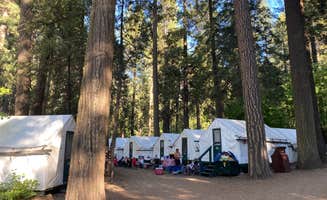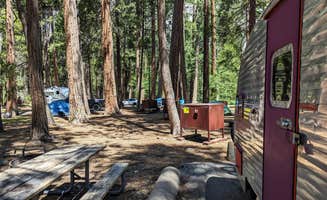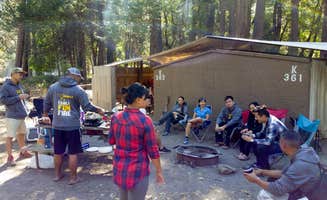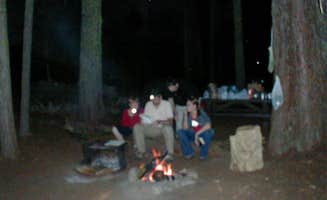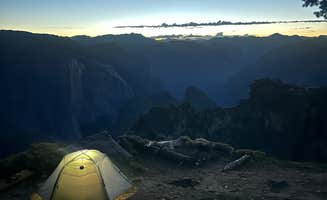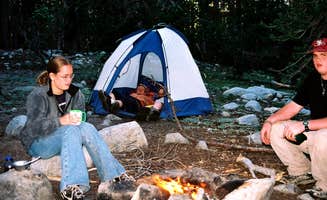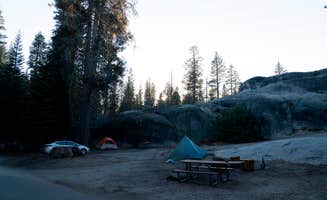Yosemite camping areas range from 4,000 to over 8,000 feet in elevation, creating distinct camping experiences and temperature variations of 10-20 degrees between valley and high country locations. At Tuolumne Meadows Campground, situated at 8,600 feet, nighttime temperatures can drop below 40°F even in summer, while daytime highs reach the 70s. The diversity in elevation also means campers can experience dramatically different ecosystems within a single trip.
What to do
Fishing at Yosemite Creek: Located near Tioga Road, this campground offers access to creek fishing. "The sites are pretty nice! The one I had was not the largest, but it was flat and secluded which I loved. They all seemed to have picnic tables and a bear box for your food," wrote Sam M. Yosemite Creek Campground provides access to beautiful hikes and fishing spots within walking distance.
Horseback riding adventures: Near North Pines Campground, you'll find horse stables for guided rides. "Great location right in the middle of Yosemite Valley. Great access to beautiful hikes and scenery. The camp sites are spacious. Because it's an equestrian campground, you will smell the horses and stables...be prepared," mentions Norina N. Rides range from 2-hour valley floor tours to full-day excursions, with prices starting at $50 per person.
Snowplay adventures: During winter months, Goat Meadow offers a designated snow play area. "When I was there recently, some of the 'campsites' had 0-3", whereas other spots were about 6-8" of snow. I was the only one in the actual snow, which was great," notes Alexander Mark C. The area becomes popular for sledding and snow activities, particularly during weekends.
What campers like
Proximity to trails: Upper Pines Campground campers appreciate easy access to popular hikes. "Great location, close by many amazing hikes! Make sure to make a reservation in advance, we were lucky enough to get 2 nights but we took some of the last spots," says Alexis P. The campground connects to several trailheads directly from the sites, eliminating the need to drive to start your hike.
River access for swimming: Wawona Campground offers refreshing river swimming opportunities during hot summer months. "Jump in the creek for a swim or walk across the road and check out the covered bridge and barn around the pioneer history center. Swimming holes all up and down those creeks," explains Kelly M. The South Fork Merced River features several calm swimming areas with natural pools just steps from campsites.
Evening activities and programs: Camp 4 offers community-building opportunities. "At the morning time campers are really friendly and my neighbors made me pancakes," shares Phillip L. Many campgrounds host ranger-led evening programs at amphitheaters, with topics ranging from wildlife to astronomy, typically starting at 8:30 pm during summer months.
What you should know
Bear management is mandatory: Every campsite in Yosemite requires proper food storage. "Each site contains a fire pit (no grill), picnic table, and four shared food lockers and is near a bathroom with drinking water and flushing toilets," explains a reviewer at Camp 4. Bears actively patrol campgrounds, especially at dawn and dusk.
Dispersed camping rules: Goat Meadow provides free camping outside park boundaries. "Close to Yosemite entrance, which was great. Stayed about a week which also crossed over Memorial Day weekend. Arrived the Tuesday before. This place gets CROWDED," warns Katelin M. Though free, the area lacks facilities and requires packing out all trash.
Heated tent cabins alternative: When temperatures drop, Curry Village offers heated accommodations. "We were expecting foam rubber mattresses on wooden plywood shelves for beds, but the bed frame, mattresses, pillows and Rumpl blankets were a nice surprise," notes Ron G. Heated cabins maintain comfortable temperatures even when outside temperatures drop below freezing.
Tips for camping with families
Reserve river sites for natural play areas: Families particularly enjoy riverside locations. "Our site was located right next to the comfort station, and in hindsight I wish we had found a place a little farther away. But besides the proximity, our site was nice with a fire pit and picnic table," shares Erin S. from North Pines. Sites along the Merced River create natural entertainment for children.
Consider Wawona for less crowding: Wawona Campground offers a more relaxed atmosphere than valley locations. "More spacious than those 'in the valley.' Semi-private. Looked like some sites were more ideal than others. River near sites," notes Benjamin C. The campground sits about 45 minutes from valley attractions but provides a quieter family experience.
Pack extra blankets for elevation camping: High-country camping requires preparation for cold nights. "This section of the park, while not as popular as the Valley, is arguably just as beautiful, and is much easier to secure camping. The elevation here means that it gets fairly cold at night, even during the summer," advises Les R. about Tuolumne Meadows. Temperature swings of 30-40 degrees between day and night are common at higher elevations.
Tips from RVers
Generator restrictions: RV camping at Yosemite National Park comes with strict generator hours. "We had a nice open camping spot. It was at the edge of Yosemite Valley. The only downside to the spot was everyone else had a RV and had their generators on at 6am," notes Sarah F. from North Pines. Generator use is restricted to 7-9 am, noon-2 pm, and 5-7 pm at most campgrounds.
RV length limitations: Large rigs face challenges at most Yosemite campgrounds. "Heavily wooded area. Great location to get to all the hikes. Good location to be in the valley. Sites are tight would not recommend a rig over 30," advises Rick L. about Upper Pines. Most valley campsites accommodate RVs up to 35 feet, with limited options for larger rigs.
Dump station locations: Several campgrounds offer dump facilities with seasonal availability. "There is a spot to RV dump and fill water. This was free when I was there (FEB) but it was clearly being renovated so might be pay in future," mentions Christine W. Upper Pines provides the most reliable year-round dump station near the entrance to the campground.


